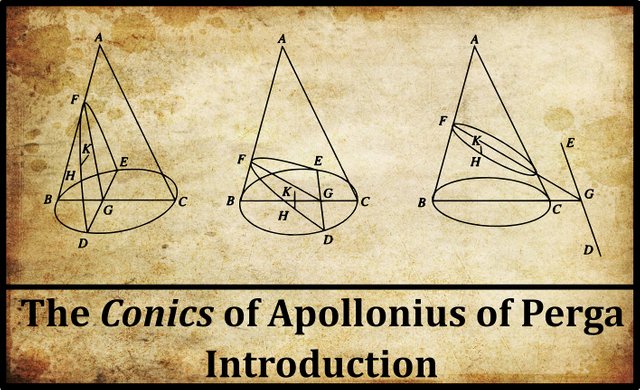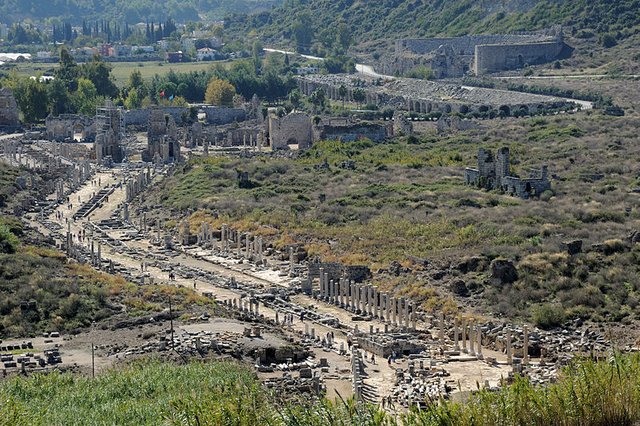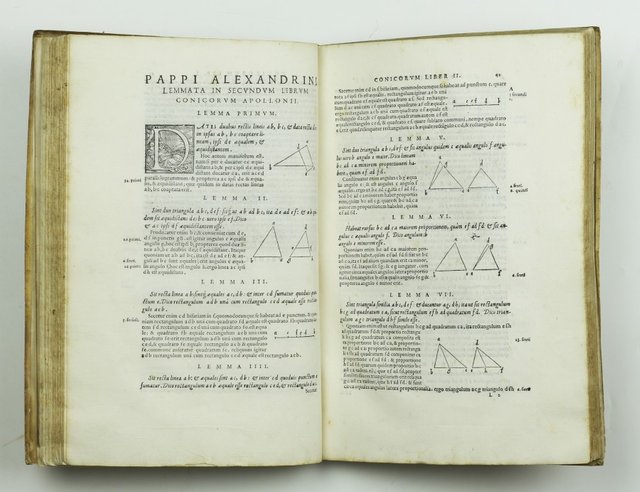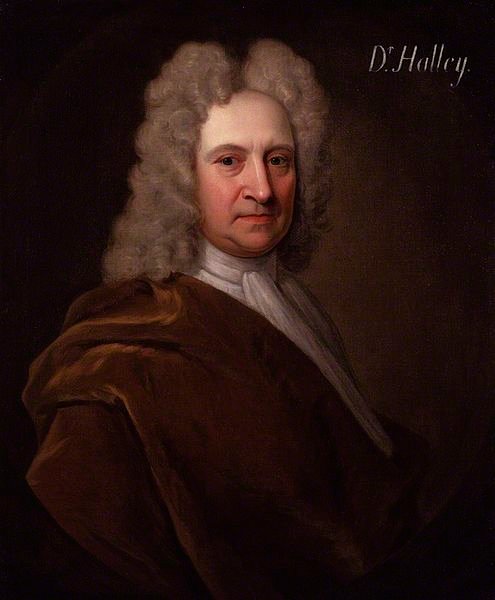The Conics of Apollonius of Perga

The Treatise on Conic Sections by Apollonius of Perga is one of the most important mathematical works to have come down to us from the Ancient World—arguably second only to Euclid’s Elements. In its current form, this work comprises a total of 387 propositions on the geometry of conic sections, which are distributed among seven books. Only Books 1-4 have come down to us in ancient Greek editions—albeit not in Apollonius’s original edition. Books 5-7 have survived only in Arabic translations. Book 8 is lost.

Life of Apollonius
We know very little about Apollonius himself. According to Eutocius of Ascalon, a 6th-century commentator on the Conics, he was born in Perga, a city in the Anatolian province of Pamphylia. The ruins of Perga still stand close to the southern coast of Turkey, about 15 km northeast of the modern city of Antalya. Eutocius also tells us that Apollonius was born sometime during the reign of Ptolemy III Euergetes of Egypt (246-221 BCE). Eutocius cites Hērakleios [Heraclius] the biographer of Archimedes as his source for this information, but who precisely this Heraclius was is still a matter of debate. Some scholars identify him with a certain Heraclids [Hērakleidēs], whom Eutocius mentions as a biographer of Archimedes in his commentary on the latter.
Eutocius’s commentary only covers the first four books of the Conics, and is the basis for our Greek text of these books—a text that probably differed significantly from what Apollonius actually wrote. Eutocius also cites Book 6 and promises to edit the remaining four books should his friend Anthemius be interested in such an edition. Anthemius, it seems, was not interested.
According to the 4th-century mathematician Pappus of Alexandria, Apollonius studied geometry in Alexandria under the students of Euclid, though this has been doubted by some scholars, who believe that Pappus had an ulterior motive for making this assertion. To Pappus we are indebted for the lemmas which he provided for all eight books of the Conics.

Ptolemaeus Chennus, a Greek grammarian who lived in Alexandria during the reigns of Trajan and Hadrian, mentions a famous Alexandrian astronomer by the name of Apollonius, who flourished during the reign of Ptolemy IV Philopator (221-204 BCE). This Apollonius is generally thought to be Apollonius of Perga. In Book 12 §1 of his Mathematical Syntaxis [The Almagest], the famous astronomer and polymath Claudius Ptolemy does briefly mention Apollonius of Perga in connection with a lemma relating to the retrogradations of planetary orbits. Apollonius espoused the geocentric model of the Solar System with its eccentric circular orbits and epicycles, but two thousand years later, Isaac Newton would show that Apollonius’s conic sections made excellent mathematical models for the planetary orbits of the heliocentric system.
The prefatory letters that introduce six of the seven extant books of the Conics have also been mined by scholars for biographical information pertaining to the author, though the authenticity of these prefaces has been questioned. Nevertheless, bringing together all ancient sources, however spurious, we can reconstruct the following biography of Apollonius:
He was born in Perga, Pamphylia, around 240 BCE.
He settled at an early age in Alexandria.
He flourished under Ptolemy IV Philopator (221-204 BCE).
He studied mathematics in Alexandria under the pupils of Euclid.
He visited Pergamon in western Anatolia, where he made the acquaintance of Eudemus of Pergamon, to whom he dedicated Books 1-3 of the Conics. The remaining books, completed after the death of Eudemus, were dedicated to Eudemus’s student Attalus, who is thought by some to have been the future King of Pergamon Attalus II Philadelphus.
He dwelt for some time in Ephesus, another city in western Anatolia. It is possible that he studied here under Eudemus before settling in Alexandria.
He was known to his contemporaries as The Great Geometer. In Alexandria, his colleagues named him Epsilon, the fifth letter of the Greek alphabet, because he continued the great tradition of Euclid (Alpha), Eratosthenes (Beta), Archimedes (Gamma) and Conon of Samos (Delta).
Books 1-3 of the Conics were probably published shortly after 200 BCE.
In addition to the Conics, he also authored several shorter treatises, none of which has survived in the original Greek.
One other treatise by Apollonius, Cutting off a Ratio [De Sectione Rationis], is extant in an Arabic translation. It was translated into Latin by Edmond Halley in 1704, six years before his edition of the Conics.
Books 1-4 of the Conics probably constitute a revision of Euclid’s no-longer extant Conics. Pappus of Alexandria tells us explicitly that Apollonius “completed Euclid’s four books of conics and added four others.”

Editions, Commentaries and Translations
The editio princeps of the surviving Greek text of Books 1-4, Latin translations of Books 1-7, and a Latin reconstruction of Book 8 (based on expectations developed in Book 7 and the lemmas which Pappus supplied for Book 8) is the 1710 edition by Edmond Halley. Halley’s edition also includes the Greek text and Latin translation of Serenus of Antinouplis’s two works On the Section of a Cylinder and On the Section of a Cone. Serenus, a 4th-century mathematician from Egypt, was the author of an important but no longer extant commentary on Apollonius. Halley’s edition also incorporates Eutocius’s commentary on the Conics (the original Greek text and a Latin translation).
In 1885 and 1886 respectively, the Danish mathematician Hieronymus Georg Zeuthen brought out Danish and German editions of The Theory of Conic Sections in Antiquity, which presents the modern reader with not only a comprehensive overview of the entire subject, but also Zeuthen’s subjective interpretation of it. Zeuthen viewed ancient Greek mathematics through the lens of geometric algebra: Greek geometry was really geometry in algebraic form, but before the necessary algebraic terminology and apparatus had been devised. Algebra was to be the Arabs’ great contribution to mathematics in the Middle Ages.

Johann Ludwig Heiberg’s 1891-93 edition of the Conics includes not only a critical edition of the Greek text of Books 1-4, but also Eutocius’s commentary on it and all extant fragments related to Apollonius’s other works. Heiberg also provides Latin translations of the Greek texts.
For over a century Thomas Little Heath’s English edition of the Conics has been the preferred choice of modern Anglophone readers. Heath has supplied an essay on the early history of this important branch of mathematics, as well as much helpful commentary on Apollonius’s difficult and unwieldy text. He has also included many diagrams, though the student is advised to construct his own—modern notation does not mean the same as it did in Heath’s day. Heath’s translation is, in his own words: Apollonius and nothing but Apollonius (Heath ix). But by his own admission, he re-edited the text for modern readers:
I first wrote out a perfectly literal translation of the whole of the extant seven Books ... The real difficulty began with the reconstructive work of re-writing the book, involving as it did the substitution of a new and uniform notation, the condensation of some propositions, the combination of two or more into one, some slight re-arrangements of order for the purpose of bringing together kindred propositions in cases where their separation was rather a matter of accident than indicative of design, and so on. The result has been (without leaving out anything essential or important) to diminish the bulk of the work by considerable more than one-half and to reduce to a corresponding extent the number of separate propositions. (Heath ix-x)
For this reason, I prefer to rely on the recent English translation by Boris Rosenfeld of Pennsylvania State University. To my knowledge, this edition has never been published but it is freely available online as a PDF. I have also managed to track down a free online PDF of Rosenfeld’s extensive notes and commentaries to his translation:
Boris Rosenfeld, Apollonius of Perga: Conics. Books 1-7, Pennsylvania State University, Online Edition (2002-2008)
Boris Rosenfeld, Commentaries on Apollonius of Perga: Conics. Books 1-7, Pennsylvania State University, Online Edition (2002-2008)

Recently, an alternative interpretation of Apollonius’s text has appeared, Apollonius of Perga’s Conica: Text, Context, Subtext, by Michael N Fried and Sabetai Unguru. The authors claim that every edition or translation of the Conics between 1886 and 2000 has been heavily influenced—whether directly or indirectly—by Zeuthen’s monumental work. Fried and Unguru have purged their edition of the Conics of all algebraic interpretations, which they believe are alien to the ancient Greek way of thinking and have distorted our modern perspective of the Conics.
References
- Apollonius of Perga, Thomas Little Heath (translator & editor, Treatise on Conic Sections: Edited in Modern Notation, with Introductions, Including an Essay on the Earlier History of the Subject, Cambridge University Press, Cambridge (1896)
- Eutocius of Ascalon, Johann Ludwig Heiberg (editor & translator), Eutocii Commentaria in Conica [Eutocius’s Commentary on the Conics], Volume 2, B G Teubner, Leipzig (1893)
- Michael N Fried, Sabetai Unguru, Apollonius of Perga’s Conica: Text, Context, Subtext, Brill, Leiden (2001)
- Edmond Halley, Apollonii Pergaei Conicorum Libri Octo et Sereni Antissensis de Sectione Cylindri et Coni Libri Duo, Oxford (1710)
- Pappus of Alexandria, Paul Ver Eecke (translator), La Collection Mathématique, Desclée de Brouwer et Compagnie, Paris (1933)
- Claudius Ptolemaeus, Gerald James Toomer (translator & annotator), Ptolemy’s Almagest, Gerald Duckworth & Co Ltd, London (1984)
- Boris Rosenfeld, Apollonius of Perga: Conics. Books 1-7, Pennsylvania State University, Online Edition (2002-2008)
- Hieronymus Georg Zeuthen, Die Lehre von den Kegelschnitten im Altertum [The Theory of Conic Sections in Antiquity], German Edition, Andr. Fred. Høst & Søn, Copenhagen (1886)
Image Credits
- The Ruins of Perga, Pamphylia, Birthplace of Apollonius: © Saffron Blaze, Creative Commons License
- An Italian Edition of the Conics (Alessandro Benacci, Bologna (1566)) with the Lemmas of Pappus of Alexandria: © 2019 Jonkers Ltd, Fair Use
- Edmond Halley: Richard Phillips (artist), National Portrait Gallery, London, NPG 4393, Public Domain
- Pages from the 9th-Century Arabic Translation of the Conics: Bodleian Library MS Marsh 667, © Bodleian Libraries, University of Oxford, Digital.Bodleian User Licence
- Boris Rosenfeld: © Sveta Katok, Fair Use

Hi harlotscurse,
Visit curiesteem.com or join the Curie Discord community to learn more.
valid post dear.. love you